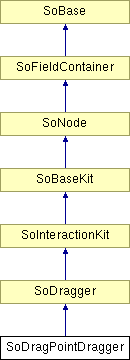
#include <Inventor/draggers/SoDragPointDragger.h>
Inheritance diagram for SoDragPointDragger::

Public Methods | |
| SoDragPointDragger (void) | |
| void | setJumpLimit (const float limit) |
| float | getJumpLimit (void) const |
| void | showNextDraggerSet (void) |
Static Public Methods | |
| void | initClass (void) |
Public Attributes | |
| SoSFVec3f | translation |
Protected Methods | |
| ~SoDragPointDragger () | |
| virtual SbBool | setUpConnections (SbBool onoff, SbBool doitalways=FALSE) |
| virtual void | setDefaultOnNonWritingFields (void) |
| void | dragStart (void) |
| void | drag (void) |
| void | dragFinish (void) |
Static Protected Methods | |
| void | startCB (void *f, SoDragger *d) |
| void | motionCB (void *f, SoDragger *d) |
| void | finishCB (void *f, SoDragger *d) |
| void | metaKeyChangeCB (void *f, SoDragger *d) |
| void | fieldSensorCB (void *f, SoSensor *s) |
| void | valueChangedCB (void *f, SoDragger *d) |
Protected Attributes | |
| SoFieldSensor * | fieldSensor |
This dragger is convenient to use when it is desirable that the end-user should interact with points by positioning them freely in 3D space.
The dragger consists of a part for 2D motion in a plane (like the SoTranslate2Dragger) and another part on the axis normal to the plane.
While the dragger is inactive (ie the user is not currently grabbing and / or dragging it's parts), the CTRL keys on the keyboard can be used to switch the orientation of the 2D-plane part and the normal-axis part so the normal-axis part points along one of the other principal axes. This is done by position the mouse pointer over the dragger geometry and pressing and releasing a CTRL key.
|
|
Default constructor, sets up the dragger nodekit catalog with the interaction and feedback geometry. |
|
|
Protected destructor. (Dragger classes are derived from SoBase, so they are reference counted and automatically destroyed when their reference count goes to 0.) |
|
|
Initializes type system for this dragger class. Application programmers should usually not have to invoke this method, see documentation of SoInteraction::initClass(). Reimplemented from SoDragger. |
|
|
The dragger plane jump limit is ignored in Coin, as we use a continuous moving plane. This method still included for API compatibility with the original SGI Inventor API. |
|
|
The dragger plane jump limit is ignored in Coin, as we use a continuous moving plane. This method still included for API compatibility with the original SGI Inventor API. |
|
|
Circulate the dragger's three different sets of geometry, to circulate the orientation of the translation axis and translation plane through the three principal axes.
This function is triggered when the user taps the |
|
|||||||||||||||
|
Sets up all internal connections for instances of this class. (This method will usually not be of interest to the application programmer, unless you want to extend the library with new custom nodekits or dragger classes. If so, see the SoBaseKit class documentation.) Reimplemented from SoInteractionKit. |
|
|
(Be aware that this method is unlikely to be of interest to the application programmer who does not want to extend the library with new custom nodekits or draggers. If you indeed are writing extensions, see the information in the SoBaseKit class documentation.)
A virtual method that should call SoField::setDefault() with argument This is typically done when:
Reimplemented from SoDragger. |
|
|
For internal use only. |
|
|
For internal use only. |
|
|
For internal use only. |
|
|||||||||||||||
|
For internal use only. |
|
|||||||||||||||
|
For internal use only. |
|
|||||||||||||||
|
For internal use only. |
|
|||||||||||||||
|
For internal use only. |
|
|||||||||||||||
|
For internal use only. Reimplemented from SoInteractionKit. |
|
|||||||||||||||
|
For internal use only. |
|
|
Continuously updated to contain the current translation from the dragger's local origo position. The application programmer applying this dragger in his code should connect the relevant node fields in the scene to this field to make it follow the dragger. |
|
|
For internal use only. Reimplemented from SoInteractionKit. |
 1.2.9 written by Dimitri van Heesch,
© 1997-2001
1.2.9 written by Dimitri van Heesch,
© 1997-2001